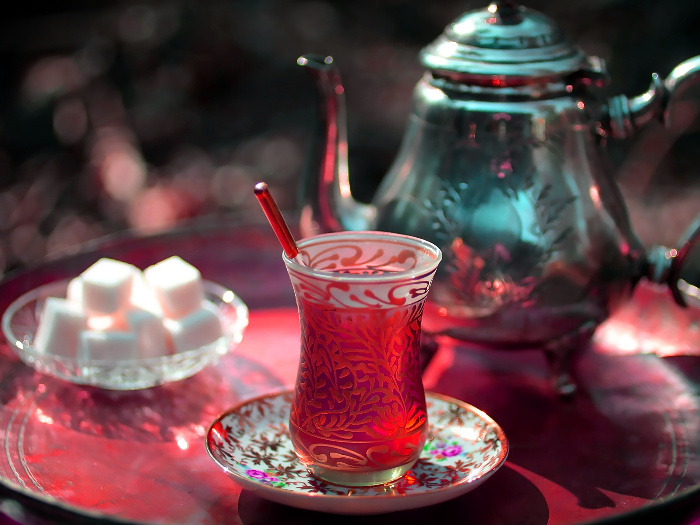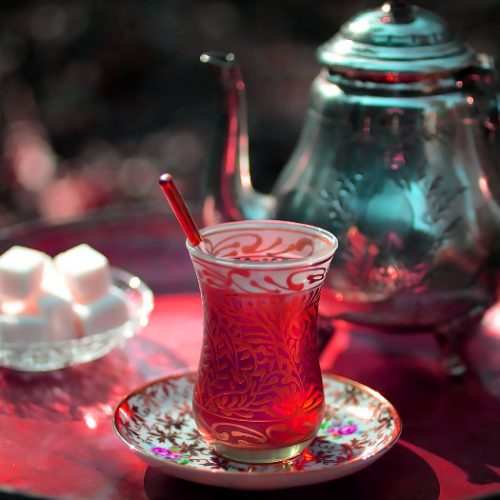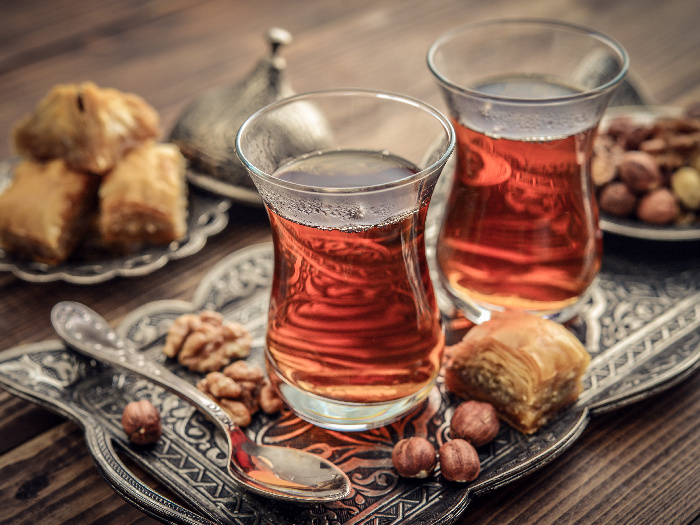Tea is an essential part of Turkish culture. People start their day with a cup of hot tea and drink it throughout the day. While coffee is equally popular, it is drunk more sparingly. Tea is the chosen beverage which accompanies breakfast, snacks, and gossip session with friends. If you were to visit a Turkish household, your host will first offer you a cup of tea to welcome you.
What is Turkish tea?
The Turkish çay, pronounce as ‘chai’ is a type of black tea. Turkey is one of the main producers of tea worldwide and most of it is consumed domestically. It is a type of black tea that is typically taken without milk. Despite its long history of coffee consumption with its own unique culture, tea is the more popular beverage. But it is a relatively new addition to the Turkish culture. It replaced coffee as the beverage of choice in hot drinks. Tea became popular after World War I when the supply of coffee became limited. Tea was encouraged as an alternative. Today its consumption far exceeds coffee.

Traditional Turkish tea. Photo Credit: Shutterstock
Serving The Tea
Turkish tea culture is distinct from Asian or European tea cultures. It has a unique manner of preparation and serving. The tea is prepared in a double-pot with the bigger one at the bottom and the smaller one on top. Water is boiled in the bottom part and tea is brewed in the top part. When the water is boiled, it is added to the pot at the top and left to brew for 10 to 15 minutes.
The brewed tea is quite strong. When serving, the brewed tea is poured into glasses and then diluted with the boiled water from the bottom pot as per personal preferences. The usual serving size is a quarter of a glass. You can make it less for people who like their tea light or make it half-a-glass for those who like it strong. The tea glass is never filled to the top. This is because tea is served not in cups, but tulip-shaped curved glasses, which do not have a handle. The drinker holds the glass by the rim and sips. So, one must leave about a centimeter free at the top for holding the glass.
The teapot, with its unique shape, is traditionally made of porcelain or copper. Today you are more likely to see teapots made of glass or steel. Tea is served in glasses with a small plate at the bottom. The traditional Turkish tea set will contain a double teapot, tea glasses with small plates, small teaspoons, and a tray.
A note here on the famous Turkish hospitality. Tea is served to welcome a guest and your host will not ask how many glasses you want. Instead, they will refill your glass once it is emptied. So, if you are done, place the glass on its plate with the teaspoon on top. This is far more effective than verbal denial which is seen as just polite refusal.
How to make Turkish tea?
Although the procedure is slightly different, making the tea is quite easy. Another advantage of this tea is that you can customize one pot of brewed tea for multiple people, making it as light or as strong as individual preferences.

Piping Hot Turkish Tea Recipe
Ingredients
- 1 tsp Turkish tea or black tea
- 2 cups water plus, extra for filling
- sugar cubes optional
Instructions
- Rinse the small pot with warm water. Pour in 1/4th of the water and add the tea leaves.
- Fill the lower pot with the rest of the water and place it on the stove with the small pot on top.
- Reduce the heat once the water comes to a boil. The steam from the boiling water at the bottom will gently heat the water in the upper pot.
- After 5 minutes, gently pour about half the water from the lower pot into the brewing pot. Add more water to the lower one, place the small pot on top, and put it back on the stove.
- Bring the water at the lower pot to a boil and reduce the heat. The steam from the simmering water keeps heating the water on top. Brew the tea for 10 to 15 minutes. The tea leaves will settle at the bottom by the end of this period.
- When serving, pour out the brewed tea into the tea glasses according to how strong you want it. The normal serving size is a quarter of a glass. Reduce the amount if you like your tea light or increase it to half-a-glass if you want your tea strong.
- Water is then added to the brewed tea in the glasses to dilute it. Turkish tea is usually served without milk or sugar. However, you may add a little sugar to sweeten it. Tea is served on small plates.

Notes
How to Make Turkish Tea Without Double Teapots?
If you are not a Turk, it is unlikely that you possess the double teapot. In that case, there are two alternatives you can follow:
With a kettle and a pot: In this method, we use the usual kettle and a small pot in place of the double pot. Boil the water in a kettle and then add the boiled water as per the recipe to a small pot containing tea leaves. Put the pot on top of the kettle and then let the water in it simmer. Meanwhile, allow the tea to brew in the smaller pot on the top.
With a double-boiler: The double-boiler acts as the double teapot. Water is boiled in the bottom pan and the tea is brewed in the pan at the top.

